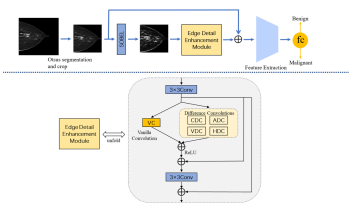
Breast cancer is the leading malignant tumor worldwide, and early diagnosis is crucial for effective treatment. Computer-aided diagnostic models based on deep learning have significantly improved the accuracy and efficiency of medical diagnosis. However, tumor edge features are critical information for determining benign and malignant, but existing methods underutilize tumor edge information, which limits the ability of early diagnosis. To enhance the study of breast lesion features, we propose the enhanced edge feature learning network (EEFL-Net) for mammogram classification. EEFL-Net enhances the learning of pathology features through the Sobel edge detection module and edge detail enhancement module (EDEM). The Sobel edge detection module performs processing to identify and enhance the key edge information. The image then enters the EDEM to fine-tune the processing further and enhance the detailed features, thus improving the classification results. Experiments on two public datasets (INbreast and CBIS-DDSM) show that EEFL-Net performs better than previous advanced mammography image classification methods.

Streaks are one of the most common print defects in electrophotographic printers that influence print quality. Streak defects are dark or light lines with the major axis along the printing process direction and are usually caused by a defective Intermediate Transfer Belt (ITB) or Organic Photo Conductor (OPC) component in the printer. Previously, we designed an algorithm to detect the streak defects only on standard printed test pages, which have uniform color [1]. In this paper, we design an algorithm to detect the streak defects on the customer content area, which we call a raster ROI. It is more complicated than the uniform color printed page because the customer content influences our streak detection result. Sometimes, the customer content has some dark or light straight lines along the printing process direction, and they are similar to streak defects. To detect the streak defects on the customer pages, we must separate the straight lines of customer content and the streak defects. To detect the streak in a raster ROI, we apply the Sobel edge detection algorithm and morphological operations to the master image, which includes the customer content without defects, to remove the straight customer content lines on the scanned test pages. The remaining dark or light straight line along the printing process direction may be streak defects. For the detected streak defects, we use the DAG-SVM multi-classification method to classify the rank of streak defects in the raster ROI.